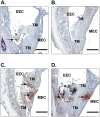Mice deficient in urokinase-type plasminogen activator have delayed healing of tympanic membrane perforations
- PMID: 23236466
- PMCID: PMC3517469
- DOI: 10.1371/journal.pone.0051303
Mice deficient in urokinase-type plasminogen activator have delayed healing of tympanic membrane perforations
Abstract
Mice deficient in plasminogen, the precursor of plasmin, show completely arrested healing of tympanic membrane (TM) perforations, indicating that plasmin plays an essential role in TM healing. The activation of plasminogen to plasmin is performed by two plasminogen activators (PAs), urokinase-type PA (uPA) and tissue-type PA (tPA). To elucidate the functional roles of PAs in the healing of TM perforations, we investigated the phenotypes of single gene-deficient mice lacking uPA (uPA(-/-)) or tPA (tPA(-/-)) after TM perforation. Delayed healing of TM perforations was observed in uPA(-/-) mice but not tPA(-/-) mice. The migration of keratinocytes was clearly delayed and seemed to be misoriented in uPA(-/-) mice. Furthermore, fibrin deposition and the inflammatory response were persistent in these mice. Our findings demonstrate that uPA plays a role in the healing of TM perforations. The observed phenotypes in uPA(-/-) mice are most likely due to the reduced generation of plasmin.
Conflict of interest statement
Figures






References
-
- Santa Maria PL, Atlas MD, Ghassemifar R (2007) Chronic tympanic membrane perforation: a better animal model is needed. Wound Repair Regen 15: 450–458. - PubMed
-
- Ma Y, Zhao H, Zhou X (2002) Topical treatment with growth factors for tympanic membrane perforations: progress towards clinical application. Acta Otolaryngol 122: 586–599. - PubMed
-
- Castellino FJ, Ploplis VA (2005) Structure and function of the plasminogen/plasmin system. Thromb Haemost 93: 647–654. - PubMed
-
- Li WY, Chong SS, Huang EY, Tuan TL (2003) Plasminogen activator/plasmin system: a major player in wound healing? Wound Repair Regen 11: 239–247. - PubMed
-
- Shen Y, Guo Y, Mikus P, Sulniute R, Wilczynska M, et al. (2012) Plasminogen is a key proinflammatory regulator that accelerates the healing of acute and diabetic wounds. Blood 119: 5879–5887. - PubMed
Publication types
MeSH terms
Substances
LinkOut - more resources
Full Text Sources
Other Literature Sources
Molecular Biology Databases
Miscellaneous

